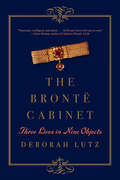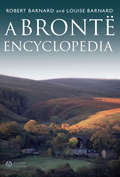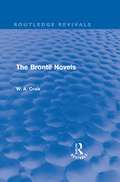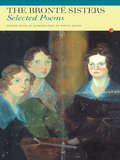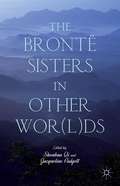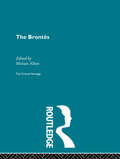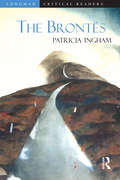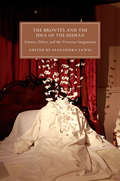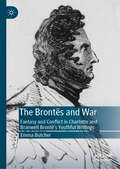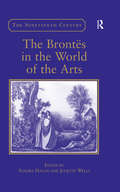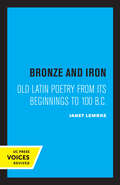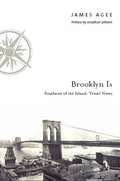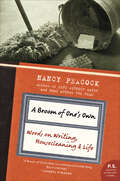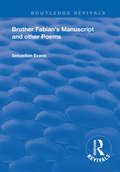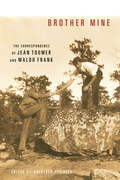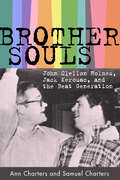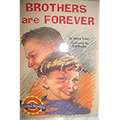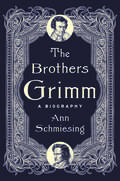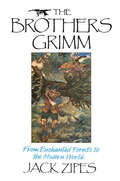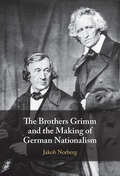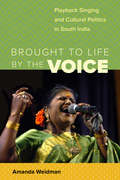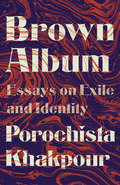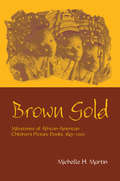- Table View
- List View
The Brontë Cabinet: Three Lives in Nine Objects
by Deborah LutzAn intimate portrait of the lives and writings of the Brontë sisters, drawn from the objects they possessed. In this unique and lovingly detailed biography of a literary family that has enthralled readers for nearly two centuries, Victorian literature scholar Deborah Lutz illuminates the complex and fascinating lives of the Brontës through the things they wore, stitched, wrote on, and inscribed. By unfolding the histories of the meaningful objects in their family home in Haworth, Lutz immerses readers in a nuanced re-creation of the sisters' daily lives while moving us chronologically forward through the major biographical events: the death of their mother and two sisters, the imaginary kingdoms of their childhood writing, their time as governesses, and their determined efforts to make a mark on the literary world. From the miniature books they made as children to the blackthorn walking sticks they carried on solitary hikes on the moors, each personal possession opens a window onto the sisters' world, their beloved fiction, and the Victorian era. A description of the brass collar worn by Emily's bull mastiff, Keeper, leads to a series of entertaining anecdotes about the influence of the family's dogs on their writing and about the relationship of Victorians to their pets in general. The sisters' portable writing desks prove to have played a crucial role in their writing lives: it was Charlotte's snooping in Emily's desk that led to the sisters' first publication in print, followed later by the publication of Jane Eyre and Wuthering Heights. Charlotte's letters provide insight into her relationships, both innocent and illicit, including her relationship with the older professor to whom she wrote passionately. And the bracelet Charlotte had made of Anne and Emily's intertwined hair bears witness to her profound grief after their deaths. Lutz captivatingly shows the Brontës anew by bringing us deep inside the physical world in which they lived and from which their writings took inspiration.
A Bronte Encyclopedia
by Louise Barnard Robert BarnardA Brontë Encyclopedia is an A- Z encyclopedia of the most notable literary family of the 19th century highlighting original literary insights and the significant people and places that influenced the Brontës' lives.Comprises approximately 2,000 alphabetically arranged entriesDefines and describes the Brontës' fictional characters and settingsIncorporates original literary judgements and analyses of characters and motivesIncludes coverage of Charlotte's unfinished novels and her and Branwell's juvenile writingsFeatures over 60 illustrations
The Brontë Novels (Routledge Revivals)
by W. A. CraikFirst published in 1968, this reissue of Dr. Craik’s critical appreciation of the completed novels of Charlotte, Emily and Anne Brontë is seminal for the way in which it shifts emphasis away from the Brontë family biography towards a detailed critical analysis of the novels themselves. Separate chapters are given to each of the seven novels. The author’s aims and techniques in each are assessed and Dr. Craik shows what light the books throw on each other, how they are related to the novels of the Brontë’s predecessors, and how the Brontë novels compare with their great contemporaries in the nineteenth century novel.
The Bronte Sisters: Selected Poems (Fyfield Books)
by Anne Bronte Charlotte Bronte Emily Jane BronteAlthough the Brontës have long fascinated readers of fiction and biography, their poetry was all too little known until this pioneering selection by Stevie Davies, the novelist and critic. Charlotte (1816-1855) is certainly a competent poet, and Anne (1820-1849) developed a distinctive voice, while Emily (1818-1848) is one of the great women poets in English. Read together with their novels, the poems movingly elucidate the ideas around which the narratives revolve. And they surprise us out of our conventional notions of the sisters' personalities: Emily's rebelliousness, for example, is counterbalanced here by great tenderness. This selection of over seventy poems gives an idea of the variety of thought and feeling within each author's work, and of the way in which the poems of these three remarkable writers parallel and reflect each other.
The Brontë Sisters In Other Wor(l)ds
by Shouhua Qi Jacqueline PadgettLooking at the works of the Brontë sisters through a translingual, transnational, and transcultural lens, this collection is the first book-length study of the Brontës as received and reimagined in languages and cultures outside of Europe and the United States.
The Brontes: The Critical Heritage
by Miriam AllottFirst Published in 1995. Routledge is an imprint of Taylor & Francis, an informa company.
The Brontes (Longman Critical Readers)
by Patricia InghamThe novels of Charlotte and Emily Bronte have become canonical texts for the application of twentieth century literary and cultural theory. Along with the work of their sister, Anne, their texts are regarded as a sources of diversity in themselves, full of conflictual material which different schools of criticism have analysed and interpreted. This book shows how the Brontes writings engage with the major issues which dominate twentieth century theoretical work. The essays are grouped under broad schools of theory- biographical; feminist; marxist; psychoanalytical and postcolonial.
The Brontës and the Idea of the Human: Science, Ethics, and the Victorian Imagination (Cambridge Studies in Nineteenth-Century Literature and Culture #115)
by Alexandra LewisWhat does it mean to be human? The Brontë novels and poetry are fascinated by what lies at the core - and limits - of the human. The Brontës and the Idea of the Human presents a significant re-evaluation of how Charlotte, Emily, and Anne Brontë each responded to scientific, legal, political, theological, literary, and cultural concerns in ways that redraw the boundaries of the human for the nineteenth century. Proposing innovative modes of approach for the twenty-first century, leading scholars shed light on the relationship between the role of the imagination and new definitions of the human subject. This important interdisciplinary study scrutinises the notion of the embodied human and moves beyond it to explore the force and potential of the mental and imaginative powers for constructions of selfhood, community, spirituality, degradation, cruelty, and ethical behaviour in the nineteenth century and its fictional worlds.
The Brontës and War: Fantasy and Conflict in Charlotte and Branwell Brontë’s Youthful Writings
by Emma ButcherThis book explores the representations of militarisim and masculinity in Charlotte and Branwell Brontë’s youthful writings. It offers insight into how the siblings understood and reimagined conflict (both local and overseas) and its emotional legacies whilst growing up in early-nineteenth-century Britain. Their writings shed new light on a period little discussed by social and military historians, providing not only a new approach to Brontë Studies, but also acting as a familial case study for how the media captivated and enticed the public imagination.
The Brontës in the World of the Arts (The Nineteenth Century Series)
by Sandra Hagan Juliette WellsAlthough previous scholarship has acknowledged the importance of the visual arts to the Brontës, relatively little attention has been paid to the influence of music, theatre, and material culture on the siblings' lives and literature. This interdisciplinary collection presents new research on the Brontës' relationship to the wider world of the arts, including their relationship to the visual arts. The contributors examine the siblings' artistic ambitions, productions, and literary representations of creative work in both amateur and professional realms. Also considered are re-envisionings of the Brontës' works, with an emphasis on those created in the artistic media the siblings themselves knew or practiced. With essays by scholars who represent the fields of literary studies, music, art, theatre studies, and material culture, the volume brings together the strongest current research and suggests areas for future work on the Brontës and their cultural contexts.
Bronze and Iron: Old Latin Poetry from Its Beginnings to 100 B.C.
by Janet LembkeThis title is part of UC Press's Voices Revived program, which commemorates University of California Press’s mission to seek out and cultivate the brightest minds and give them voice, reach, and impact. Drawing on a backlist dating to 1893, Voices Revived makes high-quality, peer-reviewed scholarship accessible once again using print-on-demand technology. This title was originally published in 1973.
Brooklyn Is -- Southeast of the Island: Travel Notes
by James Agee Jonathan LethemIn 1939, James Agee was working for Fortune magazine. Commissioned to write an article on Brooklyn for a special issue on New York, Agee moved to the Flatbush neighborhood for two months, later producing "Southeast of the Island: Travel Notes". As had earlier happened with the essay that was to become his classic portrait of southern farmers, "Let Us Now Praise Famous Men", Fortune declined to publish, and the essay remained unpublished until its 1968 Esquire appearance under the title "Brooklyn Is". In the words of Brooklyn-born novelist Jonathan Lethem, who provides the introduction to the essay in this volume, "the narrative rises up on the swirling imaged-junked cone of Agee's prophetic style to see the borough and its people whole".
A Broom of One's Own: Words on Writing, Housecleaning & Life (P. S. Series)
by Nancy PeacockFor the twice-published novelist, reading an article about herself in the National Enquirer—under the headline "Here's One for the Books: Cleaning Lady Is an Acclaimed Author"—was more than a shock. It was an inspiration.In A Broom of One's Own, Nancy Peacock, whose first novel was selected by the New York Times as a Notable Book of the Year, explores with warmth, wit, and candor what it means to be a writer. An encouragement to all hard-working artists, no matter how they make a living, Peacock's book provides valuable insights and advice on motivation, craft, and criticism while offering hilarious anecdotes about the houses she cleans.
Brother Fabian's Manuscript: And Other Poems (Routledge Revivals)
by Sebastian EvansOriginally published in 1984, Brother Fabian's Manuscript and Other Poems includes Brother Fabian's Manuscript and thirty-four additional poems.
Brother Mine: The Correspondence of Jean Toomer and Waldo Frank
by Jean Toomer Waldo FrankThe friendship of Jean Toomer and Waldo Frank was one of the most emotionally intense, racially complicated, and aesthetically significant relationships in the history of American literary modernism. Waldo Frank was an established white writer who advised and assisted the younger African American Jean Toomer as he pursued a literary career. They met in 1920, began corresponding regularly in 1922, and were estranged by the end of 1923, the same year that Toomer published his ambitiously modernist debut novel, Cane. While individual letters between Frank and Toomer have been published separately on occasion, they have always been presented out of context. This volume presents for the first time their entire correspondence in chronological order, comprising 121 letters ranging from 200 to 800 words each. Kathleen Pfeiffer annotates and introduces the letters, framing the correspondence and explaining the literary and historical allusions in the letters themselves. Reading like an epistolary novel, Brother Mine captures the sheer emotional force of the story that unfolds in these letters: two men discover an extraordinary friendship, and their intellectual and emotional intimacy takes shape before our eyes. This unprecedented collection preserves the raw honesty of their exchanges, together with the developing drama of their ambition, their disappointments, their assessment of their world, and ultimately, the betrayal that ended the friendship.
Brother-Souls: John Clellon Holmes, Jack Kerouac, and the Beat Generation
by Ann Charters Samuel ChartersJohn Clellon Holmes met Jack Kerouac on a hot New York City weekend in 1948, and until the end of Kerouac’s life they were—in Holmes’s words—“Brother Souls.” Both were neophyte novelists, hungry for literary fame but just as hungry to find a new way of responding to their experiences in a postwar American society that for them had lost its direction. Late one night as they sat talking, Kerouac spontaneously created the term “Beat Generation” to describe this new attitude they felt stirring around them. Brother-Souls: John Clellon Holmes, Jack Kerouac, and the Beat Generation is the remarkable chronicle of this cornerstone friendship and the life of John Clellon Holmes. From 1948 to 1951, when Kerouac’s wanderings took him back to New York, he and Holmes met almost daily. Struggling to find a form for the novel he intended to write, Kerouac climbed the stairs to the apartment in midtown Manhattan where Holmes lived with his wife to read the pages of Holmes’s manuscript for the novel Go as they left the typewriter. With the pages of Holmes’s final chapter still in his mind, he was at last able to crack his own writing dilemma. In a burst of creation in April 1951, he drew all the materials he had been gathering into the scroll manuscript of On the Road. Biographer Ann Charters was close to John Clellon Holmes for more than a decade. At his death in 1988 she was one of a handful of scholars allowed access to the voluminous archive of letters, journals, and manuscripts Holmes had been keeping for twenty-five years. In that mass of material waited an untold story. These two ambitious writers, Holmes and Kerouac, shared days and nights arguing over what writing should be, wandering from one explosive party to the next, and hanging on the new sounds of bebop. Through the pages of Holmes’s journals, often written the morning after the events they recount, Charters discovered and mined an unparalleled trove describing the seminal figures of the Beat Generation: Holmes, Kerouac, Neal Cassady, Allen Ginsberg, William Burroughs, Gregory Corso, and their friends and lovers.
The Brothers Grimm: A Biography
by Ann SchmiesingThe first English-language biography in over fifty years to tell the full, vibrant story of Jacob and Wilhelm Grimm, known to history as the Brothers Grimm &“Ann Schmiesing . . has brought the brothers to life in their fullness.&”—Dominic Green, Wall Street Journal &“Magisterial.&”—Kirkus Reviews More than two hundred years ago, the German brothers Jacob Grimm (1785–1863) and Wilhelm Grimm (1786–1859) published a collection of fairy tales that remains famous the world over. It has been translated into some 170 languages—more than any other German book—and the Brothers Grimm are among the top dozen most translated authors in the world. In addition to collecting tales, the Grimms were mythographers, linguists, librarians, civil servants, and above all the closest of brothers, but until now, the full story of their lifelong endeavor to preserve and articulate a German cultural identity has not been well known. Drawing on deep archival research and decades of scholarship, Ann Schmiesing tells the affecting story of how the Grimms&’ ambitious projects gave the brothers a sense of self-preservation through the atrocities of the Napoleonic Wars and a series of personal losses. They produced a vast corpus of work on mythology and medieval literature, embarked on a monumental German dictionary project, and broke scholarly ground with Jacob&’s linguistic discovery known as Grimm&’s Law. Setting their story against a rich historical backdrop, Schmiesing offers a fresh consideration of the profound and yet complicated legacy of the Brothers Grimm.
The Brothers Grimm: From Enchanted Forests to the Modern World
by Jack ZipesMost of the fairy tales that we grew up with we know thanks to the Brothers Grimm. Jack Zipes, one of our surest guides through the world of fairy tales and their criticism, takes behind the romantics mythology of the wandering brothers. Bringing to bear his own critical expertise, as well as new biographical information, Zipes examines the interaction between the Grimms' lives and their work. He reveals the Grimms' personal struggle to overcome social prejudice and poverty, as well as their political efforts - as scholars and civil servant - toward unifying the German states. By deftly interweaving the social, political, and personal elements of the lives of the Brothers Grimm, Zipes rescues them from sentimental obscurity. No longer figures in fairy tale, the Brothers Grimm emerge as powerful creators, real men who established the fairy tale as one of our great literary institutions. Part biography, part critical assessment, part social history, the Brothers Grimm provides a complex and very real story about fairy tales and the modern world.
The Brothers Grimm and the Making of German Nationalism
by Jakob NorbergIn the first comprehensive English-language portrait of Jacob and Wilhelm Grimm as political thinkers and actors, Jakob Norberg reveals how history's two most famous folklorists envisioned the role of literary and linguistic scholars in defining national identity. Convinced of the political relevance of their folk tale collections and grammatical studies, the Brothers Grimm argued that they could help disentangle language groups from one another, redraw the boundaries of states in Europe, and counsel kings and princes on the proper extent and character of their rule. They sought not only to recover and revive a neglected native culture for a contemporary audience, but also to facilitate a more harmonious and enduring relationship between the traditional political elite and an emerging national collective. Through close historical analysis, Norberg reconstructs how the Grimms wished to mediate between sovereigns and peoples, politics and culture. This title is also available as Open Access on Cambridge Core.
Brothers of the Quill: Oliver Goldsmith in Grub Street
by Norma ClarkeOliver Goldsmith arrived in England a penniless Irishman and toiled for years in the anonymity of Grub Street. Norma Clarke tells how this destitute scribbler became one of literary London's most celebrated authors, transmuting dark truths about the empire into fable and nostalgia whose undertow of Irish indignation remains just barely perceptible.
Brought to Life by the Voice: Playback Singing and Cultural Politics in South India (South Asia Across the Disciplines)
by Amanda WeidmanTo produce the song sequences that are central to Indian popular cinema, singers’ voices are first recorded in the studio and then played back on the set to be lip-synced and danced to by actors and actresses as the visuals are filmed. Since the 1950s, playback singers have become revered celebrities in their own right. Brought to Life by the Voice explores the distinctive aesthetics and affective power generated by this division of labor between onscreen body and offscreen voice in South Indian Tamil cinema. In Amanda Weidman’s historical and ethnographic account, playback is not just a cinematic technique, but a powerful and ubiquitous element of aural public culture that has shaped the complex dynamics of postcolonial gendered subjectivity, politicized ethnolinguistic identity, and neoliberal transformation in South India.
Brouhaha: Worlds of the Contemporary (Univocal)
by Lionel Ruffel Raymond N. MacKenzieWithin the hypermediated age where knowledge production is decentered and horizontal, the experience of lived time has become a concordance of temporalities. The literary imagination, which was emblematic of modernity and thoroughly connected to the book as a support structure, has now become integrated within a much vaster regime of publication. Thought concerning the world is from now on a thought concerning a plurality of worlds. By way of six guiding threads (exposition, media, controversy, publication, institutionalization, archaeology), this essay describes the transformation of cultural forms and visions of history.
Brown Album: Essays on Exile and Identity
by Porochista Khakpour*A Vintage Original*From the much-acclaimed novelist and essayist, a beautifully rendered, poignant collection of personal essays, chronicling immigrant and Iranian-American life in our contemporary moment.Novelist Porochista Khakpour's family moved to Los Angeles after fleeing the Iranian Revolution, giving up their successes only to be greeted by an alienating culture. Growing up as an immigrant in America means that one has to make one's way through a confusing tangle of conflicting cultures and expectations. And Porochista is pulled between the glitzy culture of Tehrangeles, an enclave of wealthy Iranians and Persians in LA, her own family's modest life and culture, and becoming an assimilated American. Porochista rebels--she bleaches her hair and flees to the East Coast, where she finds her community: other people writing and thinking at the fringes. But, 9/11 happens and with horror, Porochista watches from her apartment window as the towers fall. Extremism and fear of the Middle East rises in the aftermath and then again with the election of Donald Trump. Porochista is forced to finally grapple with what it means to be Middle-Eastern and Iranian, an immigrant, and a refugee in our country today. Brown Album is a stirring collection of essays, at times humorous and at times profound, drawn from more than a decade of Porochista's work and with new material included. Altogether, it reveals the tolls that immigrant life in this country can take on a person and the joys that life can give.
Brown Gold: Milestones of African American Children's Picture Books, 1845-2002 (Children's Literature and Culture #Vol. 30)
by Michelle MartinBrown Gold is a compelling history and analysis of African-American children's picturebooks from the mid-nineteenth century to the present. At the turn of the nineteenth century, good children's books about black life were hard to find — if, indeed, young black readers and their parents could even gain entry into the bookstores and libraries. But today, in the "Golden Age" of African-American children's picturebooks, one can find a wealth of titles ranging from Happy to be Nappy to Black is Brown is Tan. In this book, Michelle Martin explores how the genre has evolved from problematic early works such as Epaminondas that were rooted in minstrelsy and stereotype, through the civil rights movement, and onward to contemporary celebrations of blackness. She demonstrates the cultural importance of contemporary favorites through keen historical analysis — scrutinizing the longevity and proliferation of the Coontown series and Ten Little Niggers books, for example — that makes clear how few picturebooks existed in which black children could see themselves and their people positively represented even up until the 1960s. Martin also explores how children's authors and illustrators have addressed major issues in black life and history including racism, the civil rights movement, black feminism, major historical figures, religion, and slavery. Brown Gold adds new depth to the reader's understanding of African-American literature and culture, and illuminates how the round, dynamic characters in these children's novels, novellas, and picturebooks can put a face on the past, a face with which many contemporary readers can identify.
